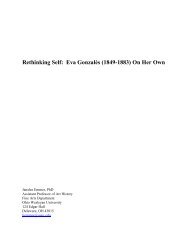2012 HUIC - Hawaii University International Conference on Arts and ...
2012 HUIC - Hawaii University International Conference on Arts and ...
2012 HUIC - Hawaii University International Conference on Arts and ...
You also want an ePaper? Increase the reach of your titles
YUMPU automatically turns print PDFs into web optimized ePapers that Google loves.
Since dance is the most repetitious, synchr<strong>on</strong>ic of all expressive behaviors, it has turned<br />
out to be a kind of touchst<strong>on</strong>e for human adaptati<strong>on</strong>. Alan Lomax, 1975<br />
Alan Lomax was an anthropologist interested in analyzing dance from different cultures,<br />
<strong>and</strong> identifying communicati<strong>on</strong> that occurred <strong>on</strong> a kinetic <strong>and</strong> subc<strong>on</strong>scious level. He<br />
searched relentlessly for footage of dance from around the world particularly, in remote<br />
locati<strong>on</strong>s. In his article, "Toward an Ethnographic Film Archive" Lomax expresses his<br />
c<strong>on</strong>cern about the changing world <strong>and</strong> the threat this had to primitive cultures. He<br />
believed that the negative bi-product of scientific progress <strong>and</strong> modernizati<strong>on</strong> was that it<br />
could cause these cultures to lose their traditi<strong>on</strong>s, rituals, <strong>and</strong> art. Dance in particular, was<br />
in extreme danger. Unlike a painting or sculpture, which can be preserved in its original<br />
form or reproduced in photographs, dance is an ephemeral art, <strong>and</strong> can <strong>on</strong>ly be<br />
understood by experiencing or observing it. Written descripti<strong>on</strong>s can <strong>on</strong>ly hint at the<br />
message the actual kinetic movement displays. Thus, Lomax felt it crucial that cultural<br />
dances be documented not through static media such as photography or written<br />
descripti<strong>on</strong>s, but through film. His film, Dance in Human History, produced in 1976,<br />
makes use of the footage he collected to dem<strong>on</strong>strate his theory of movement defining<br />
cultural traditi<strong>on</strong>s.<br />
At the American Anthropological Associati<strong>on</strong> meeting held in San Diego in the<br />
fall of 1970, Lomax presented his reas<strong>on</strong>s for preserving original dances <strong>on</strong> film. This<br />
presentati<strong>on</strong> was m<strong>on</strong>umental in the field of dance history, <strong>and</strong> as a direct result,<br />
anthropologist Margaret Mead was elected the president of the Anthropological Film<br />
Research Institute. Her work led to the establishment of The Ethnographic Film Archive<br />
in the Smiths<strong>on</strong>ian Institute in Washingt<strong>on</strong>, D.C. (Lomax, 1971). Alan Lomax <strong>and</strong><br />
Margaret Mead <strong>and</strong> other leading anthropologists dedicated themselves to filming <strong>and</strong><br />
archiving films of indigenous dances to help preserve the study of cultural traditi<strong>on</strong>s. The<br />
work of Lomax <strong>and</strong> Mead, al<strong>on</strong>g with John Wesley Powell led to the establishment of the<br />
Nati<strong>on</strong>al Anthropological Archives in 1979.<br />
Alan Lomax created the term Choreometrics to describe his study of dance as a form of<br />
expressive behavior. He took advantage of the film archive <strong>and</strong> analyzed dance styles<br />
from around the world, classifying them by the type of repetitive movements found in<br />
each culture’s dances. One of his most groundbreaking discoveries was a correlati<strong>on</strong><br />
between the type of dance movement a culture participated in, <strong>and</strong> that culture’s<br />
ec<strong>on</strong>omic status <strong>and</strong> st<strong>and</strong>ing. He described movement types in terms of dimensi<strong>on</strong>s. The<br />
most basic dance dimensi<strong>on</strong> is <strong>on</strong>e-dimensi<strong>on</strong>al style. It c<strong>on</strong>sists of linear (straight up<br />
<strong>and</strong> down) movements, which reflected the kind of work movements some<strong>on</strong>e uses when<br />
working with st<strong>on</strong>e or wood. He determined that 70% of simple ec<strong>on</strong>omies employ a<br />
<strong>on</strong>e-dimensi<strong>on</strong>al movement style. For example, people working with st<strong>on</strong>e or wood must<br />
apply careful straight strokes in order to carve into these hard <strong>and</strong> brittle mediums, <strong>and</strong><br />
also to skin animals for food <strong>and</strong> pelts clothing. Meanwhile, the two-dimensi<strong>on</strong>al style<br />
uses curved or circular movements. 80% of the ec<strong>on</strong>omies that used metal tools like<br />
sickles, which require a semicircular slashing moti<strong>on</strong> to cut wheat or other materials, also







